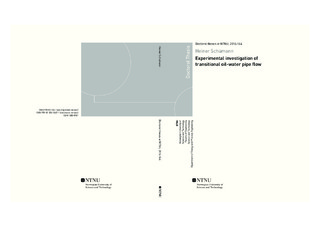| dc.contributor.advisor | Nydal, Ole Jørgen | |
| dc.contributor.advisor | Sveen, Johan Kristian | |
| dc.contributor.advisor | Tutkun, Murat | |
| dc.contributor.author | Schümann, Heiner | |
| dc.date.accessioned | 2016-07-20T12:49:08Z | |
| dc.date.available | 2016-07-20T12:49:08Z | |
| dc.date.issued | 2016 | |
| dc.identifier.isbn | 978-82-326-1667-1 | |
| dc.identifier.issn | 1503-8181 | |
| dc.identifier.uri | http://hdl.handle.net/11250/2396843 | |
| dc.description.abstract | In this thesis transitional oil-water pipe flow is experimentally studied. Here the word
transitional relates to two main topics. First, the study focuses on the investigation of
transitional flow patterns and resultant flow phenomena which neither are well described by
stratified flow nor by homogeneously dispersed flow. Second, flow development, which can
be of extensive length for oil-water flow, is investigated with help of consecutive
measurement devices arranged along the test section. The experiments were conducted in two
different multiphase flow laboratories. Tap water and different mineral oils with viscosities up
to 120mPa*s were used as test fluids.
The well flow loop at the Institute for Energy Technology (IFE) in Kjeller, Norway, provides
a transparent 25m test section with inner diameter D = 100mm, which is equipped with
advanced technology for flow visualization. Gamma densitometry and X-ray tomography
were used to obtain detailed measurements of local phase fractions and cross-sectional phase
fraction distributions. Three FBRM-probes were installed to investigate droplet size
evolution. A static inlet mixer was installed to disturb the flow and enable investigating
development of premixed flow.
The Multiphase Flow Laboratory at the Norwegian University of Science and Technology
(NTNU) provides a transparent test section which is easy to modify. A 50m long modification
with a simple ball valve installed as adjustable inlet mixer was used to investigate flow
development in terms of changing flow patterns and pressure gradients.
Onset of dispersion at considerably lower mixture velocities compared to other studies
without inlet mixing was found. Settling and inflow separation downstream of the mixing
devices was observed. The flow development was further measured in terms of changing
droplet sizes and pressure gradients. A rather dense packed droplet layer in the upper part of
the pipe was characteristic for higher input water fractions. The occurrence of the dense
packed layer always goes along with a significant increase of the pressure gradient.
A simple model for predicting the pressure gradient in dense packed layer flow was proposed.
The model considers the dense packed layer as independent phase with its own mixture properties. Model predictions are in good agreement with the measurements while the twofluid
model for stratified flow and the homogeneous flow model fail.
Furthermore, a tool for the prediction of flow development and development lengths
downstream of a mixing device was developed based on simplified settling theory. Applying
the tool together with the pressure gradient model allowed for qualitatively reproducing the
observed flow development. Locally measured pressure gradient values along the test section
could be reproduced with good agreement for low mixture velocities. For higher mixture
velocities too fast separation was predicted, as the model does not consider turbulent mixing
and droplet break-up. | nb_NO |
| dc.language.iso | eng | nb_NO |
| dc.publisher | NTNU | nb_NO |
| dc.relation.ispartofseries | Doctoral thesis at NTNU;2016:164 | |
| dc.relation.haspart | Paper 1: Schümann, Heiner; Khatibi, Milad; Tutkun, Murat; Pettersen, Bjørnar H.; Yang, Zhi Lin; Nydal, Ole Jørgen. Droplet Size Measurements in Oil–Water Dispersions: A Comparison Study Using FBRM and PVM. Journal of Dispersion Science and Technology 2015 ;Volum 36.(10) s. 1432-1443 - Is not included due to copyright available at
<a href="http://dx.doi.org/10.1080/01932691.2014.989569" target="_blank"> http://dx.doi.org/10.1080/01932691.2014.989569</a> | nb_NO |
| dc.relation.haspart | Paper 2: Schümann, Heiner; Tutkun, Murat; Yang, Zhi Lin; Nydal, Ole Jørgen. Experimental study of dispersed oil-water flow in a horizontal pipe with enhanced inlet mixing, Part 1: Flow patterns, phase distributions and pressure gradients
© 2016. This manuscript version is made available under the CC-BY-NC-ND 4.0 license http://creativecommons.org/licenses/by-nc-nd/4.0/
The final version <a href="http://dx.doi.org/10.1016/j.petrol.2016.06.005" target="_blank"> http://dx.doi.org/10.1016/j.petrol.2016.06.005</a> | nb_NO |
| dc.relation.haspart | Paper 3: Schümann, Heiner; Tutkun, Murat; Nydal, Ole Jørgen. Experimental study of dispersed oil-water flow in a horizontal pipe with enhanced inlet mixing, Part 2: In-situ droplet measurements
© 2016. This manuscript version is made available under the CC-BY-NC-ND 4.0 license http://creativecommons.org/licenses/by-nc-nd/4.0/
the final version <a href="http://dx.doi.org/10.1016/j.petrol.2016.06.022" target="_blank"> http://dx.doi.org/10.1016/j.petrol.2016.06.022</a> | nb_NO |
| dc.relation.haspart | Paper 4: Schümann, Heiner; Tutkun, Murat; Nydal, Ole Jørgen. Modeling the pressure gradient in dense packed layer flow | nb_NO |
| dc.relation.haspart | Paper 5: Schümann, Heiner; Chandra, Pannkaj; Nydal, Ole Jørgen. Oil-water pipe flow development after a valve - Is not included due to copyright | nb_NO |
| dc.relation.haspart | Paper 6: Schümann, Heiner; Kazemihatami,Milad; Nydal, Ole Jørgen. Oil-Water Flushing Experiments with Complex Pipe Geometry - Is not included due to copyright | nb_NO |
| dc.relation.haspart | Paper 7: Schümann, Heiner; Kazemihatami,Milad; Yang, ZhiLin,:Nydal, Ole Jørgen. Liquid-liquid displacement in a horizontal and inclined pipe section. Proceedings of the
9th North American Conference on Multiphase Technology, One Petro: BHR-2014-A1 | nb_NO |
| dc.title | Experimental investigation of transitional oil-water pipe flow | nb_NO |
| dc.type | Doctoral thesis | nb_NO |
| dc.subject.nsi | VDP::Technology: 500::Environmental engineering: 610 | nb_NO |

